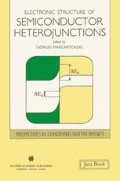Abstract
A tight-binding theory of semiconductor heterojunction band lineups is presented. Interface dipoles are shown to play a crucial role in determining lineups, so that lineups obtained by using the vacuum level as a reference (e.g., the electron affinity rule) are not reliable. Instead, the self-consistent lineup can be obtained approximately by aligning the average sp 3 hybrid energies in the respective semiconductors. Numerical results are provided and compared with experiment, and the approximations and accuracy in this approach are discussed. The application of these ideas to Schottky barriers is also considered.
Access this chapter
Tax calculation will be finalised at checkout
Purchases are for personal use only
Preview
Unable to display preview. Download preview PDF.
References
W. A. Harrison, Electronic Structure and the Properties of Solids (Freeman, New York, 1980).
W. A. Harrison, Phys. Rev. B 24, 5835 (1981), provides revised parameters, based upon Hartree-Fock, rather than the Herman-Skillman term values used in Ref. 1.
W. A. Harrison, J. Vac. Sci. Technol. 14, 1016 (1977).
J. Tersoff, Phys. Rev. B 30, 4874 (1984).
W. A. Harrison, J. Vac. Sci. Technol. B 3, 1231 (1985).
W. A. Harrison, Phys. Rev. B 31, 2121 (1985).
W. A. Harrison, R. Grant, E. Kraut, and D. J. Waldrup, Phys. Rev. B 18, 4402 (1978).
J. B. Mann, “Atomic Structure Calculations, 1: Hartree-Fock Energy Results for Elements Hydrogen to Lawrencium.” Distributed by Clearinghouse for Technical Information, Springfield, Virginia, 22151 (1967).
H. Kroemer, inProceedings of the NATO Advanced Study Institute on Molecular Beam Epitaxy and Heterostructures, Erice, Sicily, 1983, edited by L. L. Chang and K. Ploog (Martinus Nijhoff, The Netherlands, 1984). For a recent reevaluation of As/Gs, see G. Duggan, J. Vac. Sci. Technol. B 3, 1224 (1985).
C. C. Lu, T. A. Carlson, F. B. Malik, T. C. Tucker, and C. W. Nestor, Jr., At. Data 3, 1 (1971); values were extracted for He and Ce by W. A. Harrison, J. Vac. Sci. Technol. A 1, 1672 (1983).
J. Tersoff (to be published).
Y. Guldner, G. Bastard, J. P. Vieren, M. Voos, J. P. Faurie, and A. Million, Phys. Rev. Lett. 51, 907 (1983).
G. Bastard (private communication).
J. Tersoff, Phys. Rev. B 32, 6968 (1985).
J. Tersoff, Phys. Rev. Lett. 52, 465 (1984).
S. M. Sze, Physics of Semiconductor Devices (Wiley, New York, 1969).The relationship øbp=Eg — øbn is used where appropriate in extracting øbp from this tabulation.
J. Tersoff, J. Vac. Sci. Technol. B 3, 1157 (1985).
G. Margaritondo, Surf. Sci. (to be published).
O. F Sankey, R. E. Allen, S.-F. Ren, and J. D. Dow, J. Vac. Sci. Technol. B 3, 1162 (1985); O. F. Sankey (private communication).
Author information
Authors and Affiliations
Editor information
Editors and Affiliations
Rights and permissions
Copyright information
© 1988 Editoriale Jaca Book Spa, Milano
About this chapter
Cite this chapter
Harrison, W.A., Tersoff, J. (1988). Tight-binding theory of heterojunction band lineups and interface dipoles. In: Margaritondo, G. (eds) Electronic Structure of Semiconductor Heterojunctions. Perspectives in Condensed Matter Physics, vol 1. Springer, Dordrecht. https://doi.org/10.1007/978-94-009-3073-5_24
Download citation
DOI: https://doi.org/10.1007/978-94-009-3073-5_24
Publisher Name: Springer, Dordrecht
Print ISBN: 978-90-277-2824-1
Online ISBN: 978-94-009-3073-5
eBook Packages: Springer Book Archive

